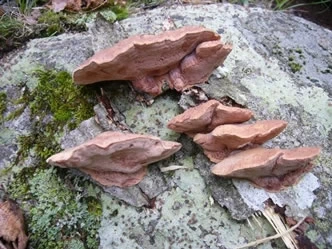Polyporic Acid in Fungi: A Brief Note
By Michael W. Beug, PhD
PO Box 116, Husum, WA 98623, email: beugm [at] evergreen.edu
In casual conversations about medicinal mushrooms with several individuals over the last month, I realized that polypores are generally considered to be non-toxic, and indeed that has long been my position. Since much of the interest surrounding the medicinal use of mushrooms involves polypores, I began to worry about individuals self-medicating with polypores they find in the wild. In mid January, 2012, I found a small soft-fleshed polypore on a conifer log and in trying to identify it found that it turned dark red in KOH. For a while I felt that I might have found Hapalopilus nidulans (Fr.) Karsten = Hapalopilus rutilans (Pers.) Murr., a polypore that few realize is very poisonous, causing most unusual symptoms including kidney dysfunction and deregulation of central nervous system functions.1
Ko, Jung and Ryvarden (2001) give the reaction between Hapalopilus nidulans and KOH as strongly cherry red, though North American collections give a lilac to violet reaction according to several different NAMA members who have emailed me recently on this subject. Even though the European species has been shown to be genetically virtually identical to the North American material, they very easily could produce slightly different versions of polyporic acid, the chemical that causes the color change. I strongly believe, but have no proof, that the color change is the result of an acid-base reaction and that any base would produce the color change by removing an acidic proton. Polyporic acid would essentially be acting as an acid-base indicator in a titration. It is well known that slight structural changes in the indicator can cause significant differences in color. It has also been established that fungi produce a wide range of different derivatives of polyporic acid (Brewer et al 1977, 1984).
The fact that the reaction between polyporic acid (a dihydroquinone derivative) and KOH causes a color change suggests that we can test for the presence of polyporic acid by applying a drop of strong base to a piece of mushroom tissue and look for a color change to lavender or red or dark red. If there is no color change, we can be confident that polyporic acid is not present in any significant quantity. However, since other chemicals can cause a similar color change, a positive reaction is not proof that polyporic acid is present. For example, Fomes fomentarius (L.) J. Kickx turns dark blood red when a drop of KOH is added to a piece of tissue from the upper surface due to the presence of fomentariol, a benzo tropolone (Arpin et al 1974).
So why do I care about the possible presence of polyporic acid in a mushroom? In two separate cases involving three people in Germany in 1986 and 1987, victims suffered dysregulation of central nervous functions as well as kidney dysfunction after consuming Hapalopilus nidulans which can contain up to 40% polyporic acid by dry weight (Langer et al 1992; Kraft et al 1998). In studies of rats that were fed polyporic acid, researchers observed ulcerations of the stomach, nephrotic lesions in kidney tubules, increases in serum concentrations of urea and creatinine as well as sensoric and motoric dysregulations consistent with symptoms observed in the human poisonings (Langer et al, 1992; Kraft et al 1987). Hepatorenal failure was also manifested as metabolic acidosis, hypokalaemia and hypocalcaemia. Both groups tied the toxic effects to the inhibition of dihydroorotate dehydrogenase with 50% inhibition at 10-4 to 10-3 M. Inhibition of dihydroorotate dehydrogenase leads to impairment of de novo synthesis of pyrimidines and inhibition of RNA synthesis. The discovery that polyporic acid is a known inhibitor of dihydroorotate dehydrogenase has led researchers to test it as an antitumor agent (Miersch, 1986).
Gill and Steglich (1987) demonstrated that polyporic acid is also present in Porostereum friesii (Lev.) Horst. & Ryv. =Hjortstamia friesii (Lév.) Bordin & Giles, Lopharia papyraceae (Jungh.) Reid, and in Phanerochaete filamentosa (Berk. & Curt.) Burds = Rhizochaete filamentosa (Berk. & M.A. Curtis) Gresl. Ko et al (2001) set out to see whether these three species were closely related evolutionarily and discovered that the answer is no. The ability to produce polyporic acid has arisen at least three and possibly four times. We do not have a complete picture of what other polypores might contain polyporic acid but one would be wise to test and investigate other polypores for a red to purple color change on application of KOH, especially closely related species like Aurantiporus alborubescens (Bourdot & Galzin) H. Jahn and Postia fragilis (Fr.) Jülich. It is quite likely that the red or purple reaction seen in other Hapalopilus species is due to polyporic acid or members of the polyporic acid family. For example Hapalopilus albocitirnus (Petch) Ryvarden turns distinctly cherry red on application of a drop of KOH, the yellow to orange reddish pores of Hapalopilus mutans (Peck) Gilb. & Ryvarden turn reddish when treated with KOH, and Hapalopilus croceus (Pers.) Donk turns red to carmine when treated with KOH (Gilbertson and Ryvarden, 1986, 1987). The deep orange pores of Hapalopilus sibiricus Núñez, Parmasto & Ryvarden turn cherry red with KOH (Roody 2003). It would be interesting to know the chemistry behind the purple-violet reaction when KOH is dropped on the pores of Ceriporia purpurea (Fr.) Donk (Breitenbach and Kränzlin 1986) and the pinkish red reaction when KOH is placed on the cap and stalk of Albatrellus skamanius (Murrill) Pouzar (Ginns 1997).
Dorothy Smullen, after reading a draft of this paper, found a reference to two Sticta species that contain polyporic acid (Murray 1952). Unfortunately, no abstract of the paper is available and purchase of the 6-page article costs over $100, so I have no other details. Dorothy also uncovered the fact that vulpinic acid (a yellow pigment found in Letharia vulpina (L.) Hue) is structurally very close to polyporic acid. In Europe and Western North America, Letharia vulpina was stuffed into carcasses of dead animals to kill wolves. It is highly toxic.
Further library research on my part turned up the fact that polyporic acid, and the structurally related compounds atromentin, bovinone, and oosporein, are common metabolic products of a number of species of fungi and function as bacterial antibiotics (Brewer et al 1984). In addition, these compounds function as anti-fungicides, decreasing vegetative growth and inhibiting spore germination of 12 species of fungi in six diverse genera (Brewer et al 1977). Polyporic acid is the active ingredient of the Chinese herbal medicine GuiZhiFuLing, made from an extract of a species of Poria (Xiao et al 2012 – please note that the reference to this paper is abbreviated in the references below because I refuse to fully cite a brief paper loaded with an obscene number of authors trying to build their reputation on paper citations and the work of others).
Among the people who collect mushrooms for natural dyes, Hapalopilus nidulans is very highly valued for the lovely purple colors that it produces. I wonder if Porostereum friesii and Rhizochaete filamentosa may also prove of value to the dye crowd. Just do not try them for medicinal effects. They are most certainly all toxic. The partially cited Xiao paper below demonstrates and extols the bioavailablilty of the polyporic acid in the herbal medicine GuiZhiFuLing. In contrast, I would be concerned about the presence of polyporic acid – yes, it might possibly be able to disrupt the growth of some cancers but it does a great deal of ancillary damage. When my doctor wanted to monitor my liver enzymes to make certain there was no harm from some medicinal mushrooms I was taking, I assured him that they were entirely non-toxic and that there was nothing to worry about from polypores. It is now clear that such is not the case for all polypores. However, it is the kidney function that needs to be monitored.

Haplopilus nidulans, © photo by Sue Hopkins

Leptoporus mollis, © photo by Michael Beug
1Jim Ginns has examined my mystery polypore and has determined that it is Leptoporus mollis.
Acknowledgments
I want to thank Ian Gibson for critiquing early drafts of this paper and making valuable suggestions.
References
- Arpin, N., J. Favre-Bonvin, W. Steglich. 1974. Fomentarol: A New Benzo Tropolone Isolated From Fomes Fomentarius. Phytochemistry 13(9):1949-1952.
- Breitenbach, J. and F. Kränzlin. 1986. Fungi of Switzerland. Volume 2: Non gilled Fungi. Lucerne: Verlag Mykologia.
- Brewer, D., W.S. Maass, A. Taylor. 1977. The Effect of Fungal Growth of some 2,5-dihydroxy-1,4-benzoquinones. Canadian Journal of Microbiology 23(7):845-51.
- Brewer, D., W.C. Jen, G.A. Jones, A. Taylor. 1984. The antibacterial activity of some naturally occurring 2,5-dihydroxy-1,4-benzoquinones. Canadian Journal of Microbiology 30(8): 1068-72.
- Gilbertson, R.L., and L. Ryvarden. 1986. North American Polypores Volume 1, Oslo: Fungiflora.
- Gilbertson, R.L., and L. Ryvarden. 1987. North American Polypores Volume 2, Oslo: Fungiflora.
- Gill, M., W. Steglich. 1987. Pigments of fungi (Macromycetes). Progress Chem Org Nat Products 51:1-317.
- Ginns, J. 1997. The taxonomy and dsitribution of rare or uncommon species of Albatrellus in western North America. Canadian Journal of Botany 75: 261-273.
- Ko, K.S., H.S. Jung and Lief Ryvarden. 2001. Phylogenetic relationships of Hapalopilus and related genera inferred from mitochondrial and small subunit ribosomal DNA sequences. Mycologia 93(2): 270-276.
- Kraft, J., S. Bauer, G. Keihoff, J. Mieersch, D. Wend, D Riemann, R. Hirschelmann, H-J Holzhausen, J. Langer. 1998. Biological effects of the dihydroorotate dehydrogenase inhibitor polyporic acid, a toxic constituent of the mushroom, Hapalopilus rutilans, in rats and humans. Arch Toxicol 72:711-721.
- Langer, J., S. Bauer, J. Miersch, F.-W. Rath. 1992. On biological influence of polyporic acid: toxicological and biochemical investigations of two intoxications of the mushroom Hapalopilus rutilans. Zeitrschrift fuer Mykologie 58(2): 173-184.
- Mieresch, J. 1986. Einfluss von Chinonen auf die mitochondriale Dihydroorotat-Dehydrogenase aus Kartoffelknollen-Parenchym. Biochem. Physiol. Pflanzen 181: 405-410.
- Murray, J. 1952. Lichens and Fungi. Part 1. Polyporic Acid in Stictae. Journal of the Chemical Society (resumed) 0(paper 246): 1345-1350.
- Roody, W.C. 2003. Mushrooms of West Virginia and the Central Appalachians. Louisville: University Press of Kentucky.
- Xiao, F. et al Fitoterapia 83(1).
This page also available as a pdf file.

NAMA Store >